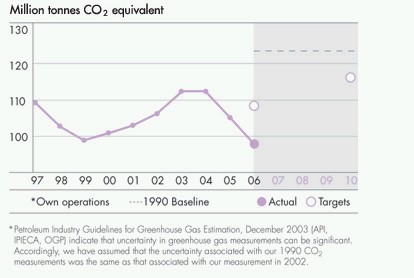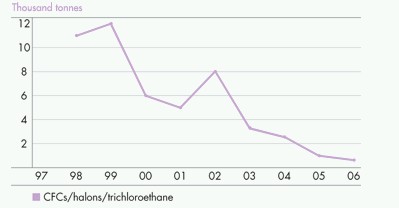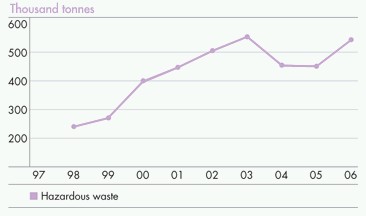Royal Dutch Shell PLC
From Lauraibm
Contents |
MI Summary
Climate Change
Managing our Emissions
Finding reductions to offset the rising emissions from our changing portfolio is getting harder. The amount of energy needed for us to produce each unit of oil or natural gas is already more than 50% higher than in 2000. It will continue to rise as our fields age and as more of our production comes from heavier oil and oil sands.
Producing more low sulphur transport fuels will help lower our customers’ CO2 emissions. However, it will also increase our direct emissions, since more refining energy is needed to make them.
So, how are we managing our emissions? We are:
- Working to end continuous flaring: Capturing and using the natural gas produced during oil production
- Improving energy efficiency in our refineries, chemical plants and production facilities
- Factoring future costs of emitting GHGs into our business decisions so our new facilities have lower CO2 designs
- CO2 capture and storage: Continuing to work on demonstration projects to drive down costs and demonstrate safety
- Measuring our GHG emissions worldwide in a consistent and transparent way
Where do our emissions come from? Our greenhouse gas emissions, most of which are CO2, typically come from:
- Combustion of fuel in our refineries and chemical plants to generate the energy required to manufacture our products.
- Flaring of associated natural gas at oil production wells. In many remote locations there is no local market for this gas and no facilities for capturing it and transporting it to an alternative market.
- Combustion of fuel at oil and gas production sites to power the necessary drilling, pumping and processing equipment.
- Combustion of fuel in ships that transport crude oil and oil products.
- Leakage of light hydrocarbon gas from storage vessels, pipes and processing equipment.
(1)
Helping energy users reduce their emissions
Managing emissions from our operations is important and our direct responsibility. But more than 80% of the CO2 from fossil fuels is emitted when energy products are used.
We recognise that our response to climate change means more than reducing our own emissions. Our customers emit six to seven times more CO2 using our products than we do making them - more than 750 million tonnes of CO2 in a typical year.
We are helping our customers use energy more efficiently through programmes like Energise™ for industrial energy users and the Fuel Stretch Campaign and Shell Fuel Economy challenge for drivers. It also means providing lower CO2 emitting energy products, so the rapid rise in energy use does not bring an equally big increase in GHG emissions. Developing advanced transport fuels, like Fuel Economy formula, that reduce fuel consumption, will help. So will expanding our natural gas business and our efforts to lower the costs and increase the use of biofuels, wind and solar power. Since a lot more coal, oil and gas will still be needed, including oil from energy intensive sources like oil sands, developing efficient ways to capture and safely store the CO2 from fossil fuels will also be critical for energy users to reduce their GHG emissions.
Lower CO2 electricity Providing clean-burning natural gas is one of our biggest contributions to slowing the growth of greenhouse gas (GHG) emissions in the power sector. Gas-fired power plants produce about half the CO2 emissions of a conventional coal-fired plant. In addition, our patented coal gasification technology, used together with combined cycle power plants, can reduce CO2 emissions by up to 15% compared to the latest conventional coal-fired power plants.
Lower CO2 transport Transport will continue to rely mainly on oil for many years to come. Reductions in GHG emissions in the transport sector will need to come mainly from blending biofuels into petrol and diesel, from technologies to improve the fuel efficiency of conventional fuels and vehicles, and from managing demand. Government policies that reward lower CO2 technology will be critical for success. (2)
Biodiversity
Approach to Biodiversity
Our Biodiversity Standard and Commitment In 2001, we were the first energy company to adopt a Group Biodiversity Standard. The Standard outlines our commitment to work with others to maintain ecosystems, respect protected areas and seek partnerships to conserve biodiversity.
Shell and Protected areas In 2003, we made additional commitments with regard to protected areas, including a commitment not to explore for, or develop, oil and gas resources in natural World Heritage Sites.
Our 2005-2010 strategy In 2005, we also developed a Biodiversity Strategy through to 2010 which includes a commitment to follow strict operating practices in protected areas classified under the World Conservation Union (IUCN) Category System as Category I-IV protected areas and in other areas of high biodiversity value.
We are currently also working on sustainability requirements for sourcing biofuels. (3)
Alternative Energy
We have been in the alternative energy business for over 20 years and in 1997 established Shell Renewables. Today we are focussing our efforts on the most promising technologies: advanced biofuel and hydrogen for transport, wind and thin-film solar for electricity.(4)
Water Use
Handling water in a responsible and sustainable way is crucial to the future of Shell operations. We use water in our refineries, chemical plants and biomass operations. We have the potential to impact on water quality when we explore for and produce oil and gas. Recognition as a responsible operator helps us attract customers and highly qualified staff, and carefully safeguarding water helps us to build trust with regulators and key stakeholders.
Acknowledging risk The public is increasingly concerned about the way water is handled. This can affect our bottom line in a number of ways: at the pump, in the financial markets and in the recruitment of highly qualified staff. The clearest risks from deteriorating water supplies and quality are water shortages, increases in the cost of water, the cost of needing to treat water prior to usage and the health of Shell people.
Building competitive advantage We recognise the growing need for water management systems that focus on recycling and conservation. From our experiences around the world it is clear that much can be done by changing wasteful attitudes to water and finding innovative ways to reduce impact. We are adopting these attitudes and techniques to address the issue of water usage more systematically. In Australia, the Shell Clyde Refinery in New South Wales has become a partner in Sydney Water’s Every Drop Counts programme, and is working to reduce water consumption and achieve savings. In Oman, we are experimenting with reed bed technology to clean contaminated water, and in Buenos Aires, Argentina, a reduction in wastewater has generated significant savings in capital investment and operational costs.
The combination of relevant skills and experience within Shell is surprising, if not unique: geophysical expertise; reservoir engineering; producing, moving, separating, chemically treating, purifying and distributing bulk fluids; and doing business in culturally diverse countries with different levels of regulation. This range of skills and experience enables us to be competitive by developing innovative technologies and partnerships that mitigate risk and cost.
Informed by Shell principles and facilitated by the experience within Shell, there are various ways to consider how to approach water, depending on the skills available and on local environmental and social issues.(5)
Performance
Greenhouse Gas Emissions
Shell measures, reports and manages the emissions of greenhouse gases (GHG) from facilities around the world where we have a controlling interest. Our long-term target is that by 2010 our GHG emissions from these facilities will be 5% or more below 1990 levels. We aim to do this despite growing our business.
About three-quarters of the greenhouse gas (GHG) emissions from our operations come from burning fuel to power our facilities. Flaring natural gas from oil wells is responsible for most of the rest.
In 2006, Shell-operated facilities emitted 98 million tonnes of GHGs, about 7 million lower than the previous year. This reduction was due primarily to reduced flaring in our Exploration & Production business. Most of this drop in flaring was caused by cuts in production due to major security problems in Nigeria. Longer term and sustained flaring reductions were achieved in 2006 mainly from operational changes to increase gas recovery to meet demand for gas in Oman and from the new equipment installed in 2005 to reduce flaring in Gabon. Emissions from our refineries and chemical plants, which are about half our total, were down slightly compared to 2005 due to reduced availability of some plants and improvements from our Business Improvement Review (BIR) and Energise™ efficiency programmes.
In 2002 we met our first target - reducing GHG emissions from our operations by 10% below 1990 levels. Our focus now is on meeting our second target: to keep these 5% below 1990 levels by 2010, even while we grow our business and the energy intensity of producing oil and natural gas increases. In 2006, our emissions were 20% below 1990 levels. (6)
Flaring
In 2006, our total flaring worldwide dropped again. This was mainly as a result of production being shut-in in Nigeria. However, operational changes to increase associated gas recovery in Oman, and new equipment installed in 2005 to reduce flaring in Gabon also helped. Since 2000, Shell Petroleum Development Company of Nigeria (SPDC) joint venture in Nigeria, which on average accounts for two-thirds of our continuous flaring, has invested more than $3 billion in equipment to capture and use gas formerly flared.
Work continued to meet our goal of ending continuous flaring by 2008 at our upstream facilities outside of Nigeria. In Nigeria SPDC's aim remains to end continuous flaring at the last facilities during 2009. New facilities around the Group are being built to avoid continuous flaring, in line with our Group-wide minimum environmental standards.(7)
Ozone Depleting Emissions
Chlorofluorocarbons (CFCs) halons and trichloroethane were formerly used widely in industry as refrigerants, propellants, cleaning solvents and in fire extinguishers. These man-made substances contribute to the thinning of the ozone layer and allow larger quantities of harmful ultraviolet rays to reach the earth.
Hydrochlorofluorocarbons (HCFCs) have been used primarily as CFC substitutes, as the environmental effects are 90% lower than those of CFCs.
The phase out of ozone depleting emissions is governed by the Montreal Protocol. CFCs, halons and trichloroethanes must be fully phased out by 2010, while HCFCs must be phased out in developed countries by 2020 and in developing countries by 2040.
Our emissions of CFCs, halons and trichloroethane have fallen by 95% since 1998. We have virtually phased out the use and inventory of chlorofluorocarbons (CFCs), trichlorethane and halons. Emissions of these three substances combined in 2006 amounted to only 0.6 tonne - 40% lower than in 2005. In 2006, Shell Shipping completed the elimination of halons on Group-owned and chartered ships. (8)
Waste Disposal
Hazardous waste
Since 1998, the amount of hazardous waste we have reported has increased steadily and significantly. This is not because we are actually producing significantly more waste, but mainly due to changes in our reporting definitions. During this period our businesses gradually implemented our new practice of counting most 'contaminated soil' as hazardous waste, and applied stricter definitions and accounting practices in monitoring and reporting of waste generation and disposal. For example drilling muds and oily soil have become defined as 'hazardous' waste across our businesses.
The jump in 2006, was mainly caused by us removing the reporting category 'contaminated soil' entirely in that year. This forced the last remaining operations to report their contaminated soil as either hazardous or non-hazardous waste. This change also increased the reported volumes of non-hazardous waste in 2006.
Where allowed under local regulations, we are also diverting hazardous waste streams that used to go to landfill or incinerated, sending them instead to industries that can use them - for example as a feedstock for metals recovery or fuel.
Non-hazardous waste
In 2006, we produced much more non-hazardous waste. It had been largely unchanged during the previous seven years. This sudden rise was caused mainly by the hurricanes in the Gulf of Mexico. The need to clean up and dispose of so much construction waste from buildings damaged increased our total amount of non-hazardous waste significantly in 2005 and 2006. The inclusion of certain types of soil into the non-hazardous waste category (see above on contaminated soil) by some of our downstream operations made a (smaller) contributed to the increase.
To help us produce and dispose of less waste, we introduced a new reporting parameter in 2007. It measures recycling and reuse - the amount of waste we send off-site for recycling and re-use or sell as raw material. This material would otherwise have been disposed of as hazardous or non-hazardous waste. (9)
Sources
- 1. Climate Change: Managing our Emissions
- 2. Climate Change: Helping Energy Users Reduce Emissions
- 3. Approach to Biodiversity
- 4. Alternative Energy
- 5. Water Use
- 6. Performance on Greenhouse Gas Emissions
- 7. Performance on Flaring
- 8. Performance on Ozone Depleting Emissions
- 9. Performance on Waste Disposal






